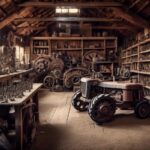Vintage tractors are not just relics; they are milestones of agricultural prowess, marking the ingenuity that has fed generations. For enthusiasts seeking to reclaim a piece of this legacy, the task of restoration can be as daunting as it is rewarding.
These projects often become a labor of love, a quest to breathe life back into engines that once roared across the fields.
Understanding the complexity of these machines and the intricacies of their eras, the seasoned restorers navigate through corroded parts and faded blueprints, a silent witness to the transformative power of agriculture.
This article is your compass through the rust and the memories, guiding you to successful restoration. As we delve into the stories of revival and the technicalities of refurbishment, rest assured that the spirit of heritage farming is within reach, inviting you to turn the page and join a community that cherishes every nut and bolt of history.
Key Takeaways
- Vintage tractors have played a crucial role in shaping modern farming practices.
- Community restoration events and engaging youth are vital for preserving agricultural heritage.
- Restoration techniques combine authentic craftsmanship and precision engineering.
- Vintage tractor clubs provide a platform for showcasing restored tractors and celebrating farming machinery heritage.
History of Vintage Tractors
The history of vintage tractors is a testament to the evolution and innovation of agricultural machinery over the past century. These iconic machines have played a crucial role in shaping the landscape of modern farming practices.
At the Heritage Center in Abilene, Kansas, a dedicated group of individuals is actively involved in restoring vintage tractors and farm equipment, preserving the rich heritage of farming technology. The collection of restored machinery is diverse, including a 1945 John Deere combine, a 1926 Woods Brothers Hummingbird Threshing Machine, a 1928 Model A, a McCormick-Deering Farmall, and a 1947 Chevrolet. Notably, among the collection is a 1918 Heider tractor, marking its centennial this year.
The restoration efforts are a collaborative endeavor, with a group of men meeting regularly at the Heritage Center to work on these projects. Initiated by Austin Anders and Steve Marston, the restoration project serves as a platform to bring together like-minded individuals passionate about vintage tractors and their historical significance in agriculture.
The meticulous restoration work ensures that these vintage tractors are not just preserved but also celebrated for their enduring contribution to farming practices.
Community Restoration Events
In the realm of vintage tractor restoration, an integral aspect that perpetuates the preservation of agricultural heritage is the organization and participation in community restoration events. These events serve as platforms for individuals to come together and work on reviving vintage tractors, fostering a sense of camaraderie and shared purpose.
Typically held at heritage centers or museums, these events provide a hub for enthusiasts to share their passion and knowledge, creating a supportive and collaborative environment. Participants in these restoration events bring forth a wealth of skills and resources, contributing to the revival of vintage tractors and farm equipment, thereby playing a crucial role in preserving agricultural history.
Moreover, these events aim to engage younger generations, offering hands-on experiences to promote interest in agricultural heritage. By involving diverse community members in the collective effort of tractor restoration, these events not only contribute to the physical preservation of vintage tractors but also nurture a sense of belonging and shared responsibility.
Ultimately, community restoration events are fundamental in ensuring the continuity of vintage tractor restoration projects and the perpetuation of agricultural heritage.
Importance of Heritage Preservation
A critical aspect of heritage preservation lies in its capacity to safeguard the historical, cultural, and social significance of vintage tractors and farm equipment. The importance of heritage preservation can be understood through the following points:
- Connection to Agricultural Roots: Heritage preservation maintains a connection to our agricultural heritage, honoring the hard work and ingenuity of past generations.
- Education of Future Generations: Preserving vintage tractors allows for the education of future generations about the evolution of farming practices and machinery, offering insights into the advancements made over time.
- Conservation of Unique Equipment: Heritage preservation efforts contribute to the conservation of unique and rare equipment, ensuring that it is not lost to time and remains accessible for study and appreciation.
- Fostering Community Pride: By reviving and showcasing vintage tractors, heritage preservation fosters a sense of community pride and appreciation for agricultural history, creating a shared sense of belonging and identity.
Techniques for Tractor Restoration
Employing time-honored craftsmanship and precision engineering, the techniques for restoring vintage tractors exemplify a meticulous dedication to preserving their historical significance and enduring charm. Skilled artisans meticulously revive each tractor, ensuring attention to detail and historic appeal.
The restoration process is a blend of authentic craftsmanship and precision engineering, enhancing the performance and historical appeal of vintage tractors. These restoration efforts also offer customization options to reflect personal style and needs, providing a tailored experience for each enthusiast.
The focus on essential maintenance, collision repairs, smoke checks, oil change services, and tire services ensures prolonged durability and optimal performance. Restoring vintage tractors requires a deep-rooted passion for preserving their heritage and enduring spirit.
Each restoration is a testament to the enduring legacy of these iconic machines, celebrating their historical significance and ensuring that they continue to captivate and inspire for generations to come.
Engaging Youth in Restoration Projects
Engaging youth in vintage tractor restoration projects offers numerous benefits. This includes the preservation of agricultural heritage and the transmission of traditional craftsmanship and engineering skills to younger generations.
By involving young people in restoration efforts, communities can cultivate a sense of pride and accomplishment. This contributes to the preservation of unique and historic equipment.
Furthermore, organizing educational workshops and community events can create opportunities for youth to engage with vintage machinery. This fosters a deeper appreciation for agricultural history and heritage.
Youth Involvement Benefits
Youth involvement in vintage tractor restoration projects cultivates a diverse range of valuable skills and fosters a deeper appreciation for agricultural heritage and tradition. This engagement brings several benefits:
- Skill Development: Restoration projects help youth develop skills in mechanics, teamwork, project management, budgeting, planning, and marketing.
- Heritage Appreciation: Youth learn about the rich heritage of agricultural machinery, fostering a deeper appreciation for history and tradition.
- Leadership and Confidence: Involvement in restoration projects fosters leadership skills and confidence as youth actively contribute to the community.
- Intergenerational Learning: Restoration efforts create a platform for older members to pass on knowledge and expertise to the next generation, promoting intergenerational learning.
Engaging young people in restoration efforts through programs like the Chevron Tractor Restoration Competition and involving organizations like FFA is crucial for preserving agricultural heritage and ensuring the continuation of interest and support for agricultural history.
Learning Restoration Skills
Learning restoration skills in vintage tractor projects not only provides valuable hands-on experience but also contributes to the preservation of agricultural heritage. Engaging youth in restoring tractors not only imparts craftsmanship and precision engineering knowledge but also instills a sense of pride in preserving historical farming equipment. Moreover, customization options allow young enthusiasts to express their personal style and meet specific needs, fostering a sense of ownership in the restoration process. High schools can play a pivotal role in this endeavor by integrating restoration projects into their curriculum, providing a platform for practical learning and community engagement. The table below showcases the diverse skill set that youth can develop through participation in vintage tractor restoration projects.
| Skills Developed | Benefits |
|---|---|
| Craftsmanship | Precision engineering knowledge |
| Historical preservation | Personal style expression |
| Community engagement | Practical learning platform |
Preserving Heritage Knowledge
Preservation of heritage knowledge through involvement in restoration projects is an impactful way to impart craftsmanship, historical understanding, and a sense of community engagement to the younger generation. Engaging youth in vintage tractor restoration efforts not only ensures the preservation of traditional skills but also fosters a deeper connection to agricultural history.
This involvement provides an opportunity for the transfer of essential knowledge and values from older generations to the youth, creating a sense of continuity and identity within the community. Through active participation in restoration projects, young individuals can develop a profound appreciation for the significance of heritage knowledge and its relevance in modern-day society.
Benefits of Engaging Youth in Restoration Projects:
- Transfer of traditional craftsmanship skills
- Understanding of agricultural history
- Fostering a sense of community belonging
- Preservation of heritage values and knowledge
Benefits of Vintage Tractor Clubs
Membership in vintage tractor clubs offers enthusiasts a unique opportunity to immerse themselves in a rich community dedicated to the preservation and celebration of agricultural heritage. Within these clubs, individuals find a sense of belonging and camaraderie, forging friendships and connections with like-minded enthusiasts who share a passion for tractors and agricultural history.
Joining a vintage tractor club provides access to a wealth of knowledge and expertise, allowing members to learn from one another and collaborate on problem-solving related to restoration and maintenance. Additionally, participation in these clubs often includes the chance to showcase restored tractors at events, shows, and parades, enabling members to proudly display their hard work and share their passion with others.
Vintage tractor clubs also frequently organize educational workshops and skill-building activities, equipping members with valuable resources and support for their restoration endeavors.
Ultimately, being part of a vintage tractor club fosters a sense of pride and fulfillment in contributing to the preservation of agricultural heritage, ensuring that these historical machines are celebrated and enjoyed for years to come.
Showcasing Restored Tractors
Restoring vintage tractors to their former glory requires meticulous attention to detail, as each meticulously refurbished machine is a testament to the enduring legacy of agricultural history. Showcasing these restored tractors plays a crucial role in preserving and celebrating the heritage of farming machinery.
The Heritage Center in Abilene, Kansas, provides a platform for these beautifully restored tractors, attracting enthusiasts and history aficionados alike. The showcasing of restored tractors is not limited to the Heritage Center; they are also featured in parades, fall festivals, and various events, drawing attention to the rich history and craftsmanship of these machines.
The exhibition of unique and historic tractors, such as the 1918 Heider tractor turning 100 years old this year, evokes a sense of nostalgia and pride in the community. The meticulous restoration work, often carried out by skilled professionals like those at BRM Plant Restoration + Engineering Services, ensures that these tractors not only look pristine but also function with the same historic charm as they did decades ago.
This dedication to preserving the legacy of brands like John Deere through meticulous restoration efforts creates a sense of belonging and pride within the community.
Future of Vintage Tractor Restoration
The legacy of vintage tractor restoration efforts not only cherishes the rich history of agricultural machinery but also paves the way for innovative advancements and preservation strategies within the industry. These restoration initiatives hold significant promise for the future of vintage tractor restoration.
Organizations such as the National FFA are instrumental in shaping this future. The National FFA Convention serves as a platform for young enthusiasts to engage with heritage and innovation in agricultural machinery. It fosters a sense of belonging and community among the next generation of restoration experts.
Moreover, the integration of modern engineering techniques into restoration processes, as seen in BRM Plant Restoration + Engineering Services in Northern Ireland, showcases a promising direction for the future. This fusion of tradition and technology not only ensures the preservation of vintage tractors but also enhances their performance and functionality.
Additionally, the community involvement and educational workshops conducted by restoration groups, such as the one in Abilene, Kansas, signify a commitment to passing on restoration skills and knowledge to future generations.
The future of vintage tractor restoration appears bright, with a strong emphasis on preserving heritage while embracing innovation.



